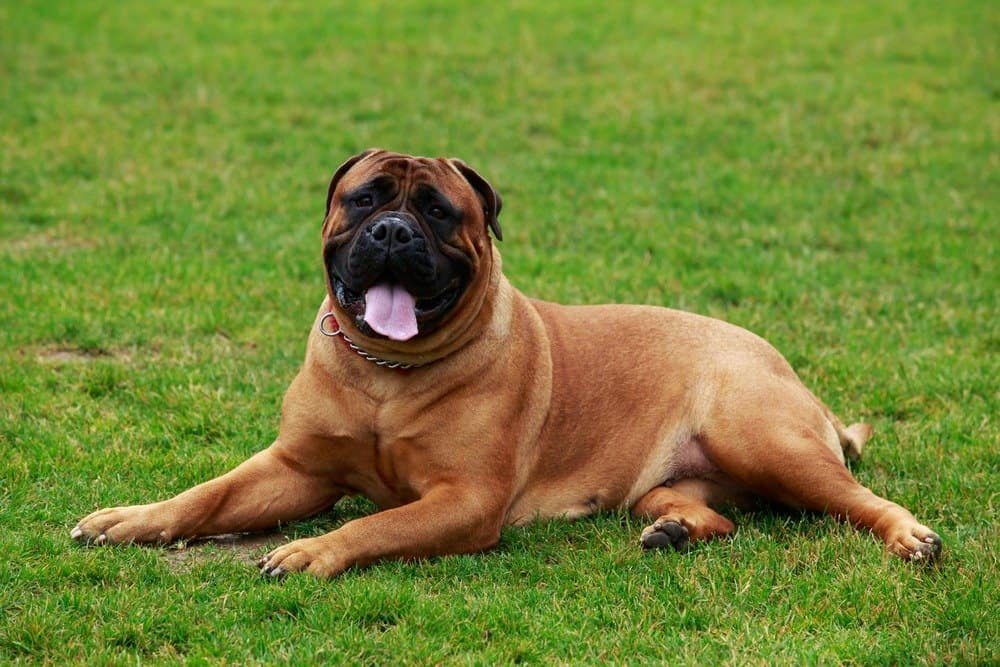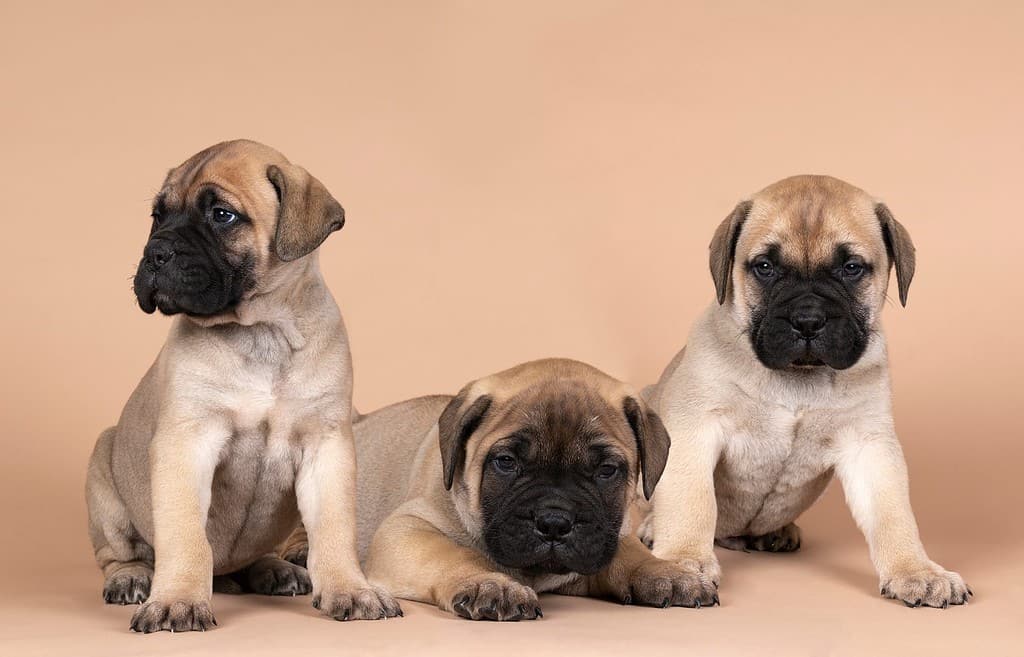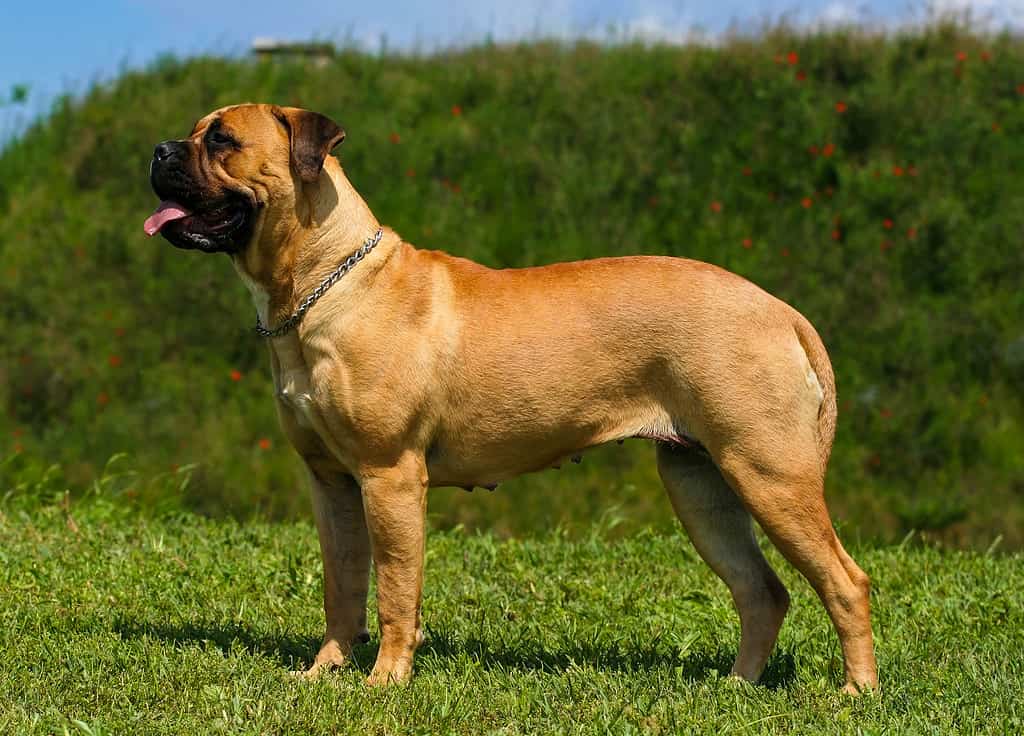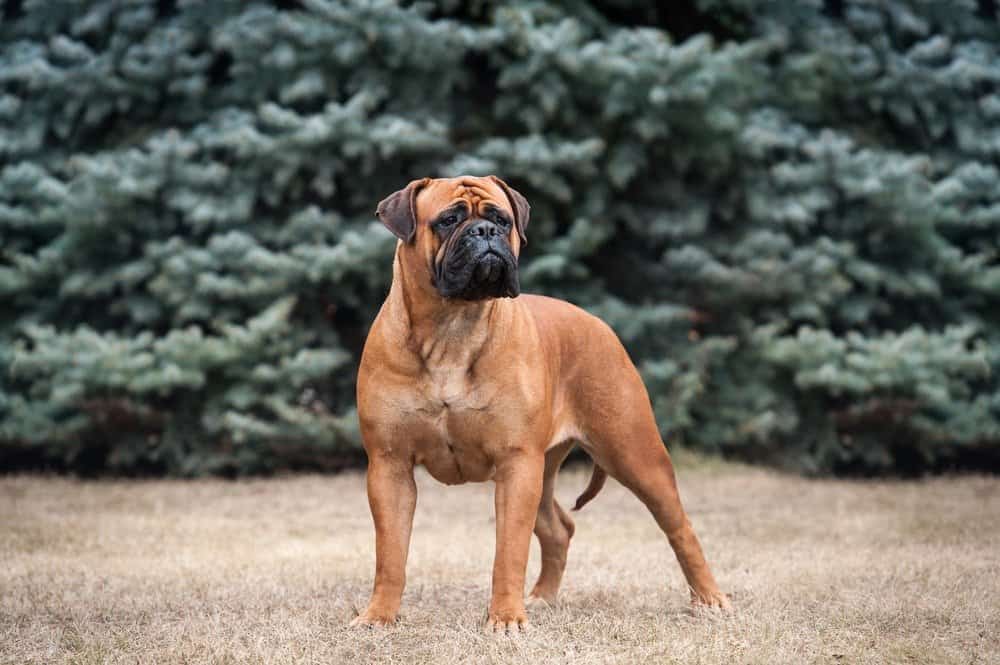The Bullmastiff breed is large and muscular and can have red, fawn, or brindle coats. They’re guarders who work fearlessly but are more docile at home, where they feel comfortable. You can expect a family companion and protector if you have a bullmastiff.
These dogs result from crossing Mastiffs and Bulldogs, although they don’t get as big as a Mastiff. Keep reading to learn more about bullmastiff progression and other things you should know.
Bullmastiff Growth and Weight Chart by Age

Bullmastiffs can reach 135 pounds, although the number varies for individual dogs.
©Olga Aniven/Shutterstock.com
This chart shows the average weight range for bullmastiff progression at various ages. Individual dogs may vary, but this provides a general idea of what to expect based on averages.
| Age | Male Weight (lbs) | Female Weight (lbs) |
| Birth | 1-2.5 | 0.9-2 |
| 1 Month | 10-15 | 8-12 |
| 2 Months | 20-30 | 18-25 |
| 3 Months | 30-40 | 27-37 |
| 4 Months | 40-60 | 35-50 |
| 5 Months | 55-75 | 45-60 |
| 6 Months | 65-85 | 55-70 |
| 9 Months | 80-105 | 65-85 |
| 12 Months | 95-125 | 75-95 |
| 2 Years | 105-135 | 85-110 |
When Will My Bullmastiff Stop Growing?
Your bullmastiff will stop growing taller when they’re around 18 months old. However, they can continue gaining weight and filling out their body until they’re between two and three.
Regular check-ups with a vet can help ensure your bullmastiff is growing at a healthy rate. Plus, feeding your pet 3⅛ – 4⅛ cups of food daily, split between two meals, helps ensure they’re healthy and have the nutrients they need to grow. Keeping water available for them to drink is also helpful.
How Big Will My Bullmastiff Be When It’s Fully Grown?
A bullmastiff can grow to 27 inches tall at the shoulder. It’ll likely weigh between 100 and 130 pounds, making it a large dog.
When Should My Bullmastiff Be Spayed or Neutered?
Consider getting your bullmastiff spayed or neutered between 12 and 18 months old. Smaller breeds can have the surgery between six and nine months, but bigger breeds should do it a little later.
Having your bullmastiff spayed or neutered too soon can lead to health issues, including Lymphoma and hip dysplasia. It can also affect their growth, so waiting until growth plates have closed is ideal.
When Should My Bullmastiff Be House Broken?
You should begin the house-breaking process immediately to help your pet get used to going in a designated area. After meals and naps, you can take them outside and reward them for going potty out there. Officially, you should start enforcing going outside when they’re between eight and 12 weeks.
Housebreaking your bullmastiff requires watching for your pet’s cues indicating they need to go potty. Following a schedule and avoiding making your pet hold their bladder for too long are also helpful.
When Should My Bullmastiff Stop Eating Puppy Food?
Your bullmastiff should stop eating puppy food between 12 and 18 months. It’s best to discuss it with your vet to determine when to stop giving it and which food to switch to when it’s time.
When Will My Bullmastiff Start Losing Teeth?
A bullmastiff puppy typically starts losing baby teeth between 3 and 4 months old. When they lose teeth, they can experience teething pain just like a human.
If you suspect your dog is suffering, you can give them soft food instead of their regular hard diet until they feel better. You can also get them teething toys to use during this time.
When Should I Start Training My Bullmastiff?
Training and socializing your bullmastiff should begin early. Since they are large guard dogs, you should start the process while they’re small enough to control.
Starting early with training regimens and instilling routines and rules as they grow is the best way to do it. Not only does it encourage agility and obedience, but it also promotes a lifelong bond between you and your bullmastiff.
What Commands Should I Teach My Bullmastiff First?
The first commands your bullmastiff should know include “sit”, “come”, “down”, and “stay”. Once they master those commands, you can move on to harder ones, including “drop it” or “leave it” to get your pet to leave an object alone or drop one they’ve already picked up. Using positive reinforcement during training is the best way to promote obedience.
Pictures of Bullmastiff Progression as Puppies

Bullmastiff puppies are small, but they grow quickly.
©Leoniek van der Vliet/Shutterstock.com

You should start training a bull mastiff when they’re a puppy while you can still control them.
©Rondon – Public Domain
Pictures of Fully Grown Bullmastiff

Bullmastiffs are protective but make great family dogs.
©iStock.com/Wavetop

A bullmastiff’s protective nature means they aren’t always friendly to strangers.
©BORINA OLGA/Shutterstock.com
Other Dog Breeds Similar to Bullmastiff
The photo featured at the top of this post is © BORINA OLGA/Shutterstock.com
Ready to discover the top 10 cutest dog breeds in the entire world?
How about the fastest dogs, the largest dogs and those that are -- quite frankly -- just the kindest dogs on the planet? Each day, AZ Animals sends out lists just like this to our thousands of email subscribers. And the best part? It's FREE. Join today by entering your email below.
Thank you for reading! Have some feedback for us? Contact the AZ Animals editorial team.






